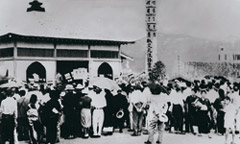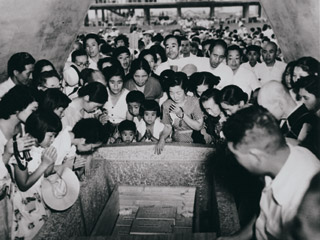 |
| Sixty Years for Hiroshima | ||||||||||||||||||
|
August 6, 1945. A single atomic bomb destroyed the city of Hiroshima and killed approximately 140,000 people by the end of December. In an instant, precious family members were stolen away, homes blazed, and beloved neighborhoods vanished. Those who fled the conflagration and survived still bear emotional scars and radiation's relentless menace to their health.
The past 60 years have seen great changes in the hearts of the hibakusha, specifically, their transition from silence to action. Through the desperate post-war turmoil, most refused to speak about the unbearable past. Then, as they came to understand the meaning of their A-bomb experiences, they began to share their dreadful stories. That process gave birth to various activities, from A-bomb literature to the peace movement. The exhibition in this room, Sixty Years for Hiroshima, tells the story of the peace activities developed by the people since the war. However, countless Hiroshima residents have engaged in an enormous variety of peace activities. Only a few can only be presented here. |
||||||||||||||||||
|
Remembrance・Memorials・Prayer
High-rise buildings tower over streets busy with traffic. At first glance, the recovered city appears no different from other Japanese cities. However, still sleeping in the soil of this city are the bones of A-bomb victims.
Last year, 59 years after the atomic bombing, the bones of another estimated 85 persons were unearthed on Ninoshima Island in Hiroshima Bay. Ever since the bombing, the remains of countless victims have been discovered in and around the city-by chance at construction sites or through information provided by a witness to those events. The Atomic Bomb Memorial Mound built in Peace Memorial Park in 1955 contains the identified but unclaimed remains of 831 persons (as of June 20, 2005) and the unidentified remains of roughly 70,000. Today, Hiroshima has many monuments to the bombing. The bereaved city built memorials to mourn victims at schools, workplaces, and in residential neighborhoods. Memorial ceremonies are held at many of these sites, usually on or around August 6. These monuments throughout the city express Hiroshima's prayer for peace even as they lay bare the wounds of the heart that continue to pain survivors. |
||||||||||||||||||
|
||||||||||||||||||
|
||||||||||||||||||
Remains Continually Unearthed
|
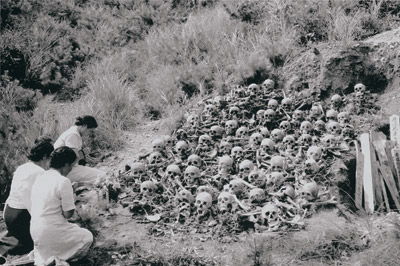 56*Remains unearthed in Saka-cho July 30, 1952 Saka-cho, Aki-gun Courtesy of Chugoku Shimbun Remains of victims are still discovered in and around the city, moving their relatives to shed new tears. The photo shows remains unearthed in Saka-cho, a suburb of Hiroshima, in 1952 (seven years after the bombing). After the bombing, the army built a temporary relief station on this spot. Discovered were the remains of 216 bodies, 156 that had been cremated and another 60 that had simply been abandoned on the grassy field. |
||||
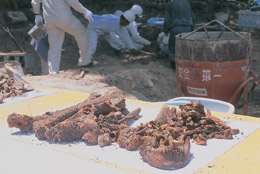
|
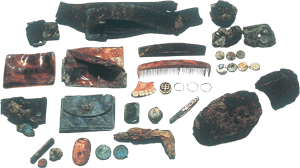 |
|||
|
57*Remains found on Ninoshima Island
June 28, 2004 Ninoshima-cho Photo by and courtesy of Michio Ide Most of the major discoveries of remains had occurred by the latter half of the 1950s, but new information from someone who was there would sometimes lead to a dig, or a construction project would uncover remains by accident. The photo shows remains discovered on Ninoshima Island in Hiroshima Bay in 2004. An estimated 85 victims were unearthed in this spot. The remains of 617 victims had been unearthed previously on the island in 1971. | ||||
Memorial Projects
|

|
56*Memorial services around Hiroshima
May 1953 Ushita campus of Hiroshima Jogakuin Courtesy of Hiroshima Jogakuin Archives A total of 58 memorial services are known to have been held by the end of 1945. Schools, workplaces, neighborhood associations and other institutions held Buddhist prayer services or memorial services for the dead before classes, work, or other normal operations resumed. Such events around August 6 are held in various locations. The photo shows the completion ceremony and memorial service held by Hiroshima Jogakuin in 1953. |
|||
|
60*Memorial on the waterfront
August 6, 1958 Honkawa River Photo by Yuichiro Sasaki Courtesy of Kiyomi Sasaki Fleeing the flames and desperate for water, people scrambled to the edges of the seven rivers flowing through the city. Countless victims perished there. Riverside memorial ceremonies near the hypocenter began in 1947. Large-scale lantern floating events by religious groups, commercial organizations, and youth organizations began in 1952. The photo shows a boat ceremony held by the Hongwanji Hiroshima Betsuin Temple. |
||||

|
||||
| Rising from the Ruins -the Peace Memorial Museum and Hiroshima
1945-1954 Collecting Rubble on the Burnt Plain 1955-1974 Buildings Rising from the Ruins 1975-1990 A Place to Tell the A-bomb Story 1991 - Conveying the Spirit of Hiroshima to the World Eyes of the World Visitors to Hiroshima Museum Statistics Sixty Years for Hiroshima Preservation・Restoration・For Posterity Memories・Inheritance・Communication Conclusion Return to TOP |
